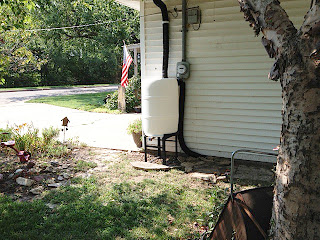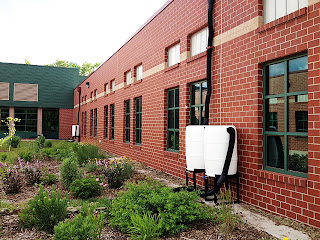RAIN BARREL VOUCHERS ARE BACK!
more info to come soon.........
Keep conserving water regardless of city’s decision to hold off on usage fines
- By Annie Calovich
As we continue to get more rain (thank
heaven!), the Wichita City Council has delayed raising water rates or
imposing fines for high water usage, though the restrictions will be
revisited, perhaps in July.
Instead, conservation is the
watch-word, and the city is finalizing details of a program that will
offer rebates for purchases of high-efficiency appliances and smart
sensors on sprinkler systems ($100) and rain barrels ($75). Stay tuned
for the particulars — such as how many rebates per household, and is
that cash or a credit to your water bill? — which may be known by the
end of next week.
Coincidentally, Peter Daniels of Wichita Rain Barrels will be at Botanica on Wednesday to give a lunchtime lecture on rain barrels; it’s at 12:15 p.m. and included in Botanica admission. He’ll also have barrels for sale.
There’s never any reason, in any season, for wasting water, and we’ll continue in The Eagle to look at ways to use only what we need. Feel free to send me your ideas. I know that the drought has caused me to reassess my water usage — from not leaving the water running out of the hose while I run to shut off the spigot (a watering wand or nozzle with a shut-off valve is essential) to saving kitchen-sink water that otherwise would run down the drain, such as when I’m rinsing certain things out, for use on houseplants. The conservation has to be simple and quick for me to do it.
While the city government looks for ways to conserve water, I hope officials will nonetheless realize that people who may not be watering gardens at home — along with everyone else — do benefit from public fountains and gardens. Maintaining refreshing and beautiful communal areas is an efficient and good use of water. I hope that the fountains will once again be turned on, and that the city spends more, not less, on our public spaces.
The spring in other ways continues to be a Twilight Zone for me. I am grateful, above all, for the rain. And, after that, for the ability to have windows and blinds open. But temperatures in the 70s have not matched up with the fact that the pools are open and that I don’t have to slow down for school zones on my way to work. Next week’s forecast will take care of that, though.
In the meantime, because we haven’t had to water, and because rain has kept the soil moist, there’s no excuse for not getting after weeds this year. Squatting, bending, pulling — all these movements are good for people who sit at a desk all day. Those of us with back problems should probably still sit for weed-pulling, however. I don’t usually set aside time to weed. I just start pulling when I see what I don’t like, and go for a little while, until the next time, which had better be soon.
The weeds will only get harder to dig out, and the weather will drive us into the AC faster, as the summer unfolds. At least that’s how I remember it.
Coincidentally, Peter Daniels of Wichita Rain Barrels will be at Botanica on Wednesday to give a lunchtime lecture on rain barrels; it’s at 12:15 p.m. and included in Botanica admission. He’ll also have barrels for sale.
There’s never any reason, in any season, for wasting water, and we’ll continue in The Eagle to look at ways to use only what we need. Feel free to send me your ideas. I know that the drought has caused me to reassess my water usage — from not leaving the water running out of the hose while I run to shut off the spigot (a watering wand or nozzle with a shut-off valve is essential) to saving kitchen-sink water that otherwise would run down the drain, such as when I’m rinsing certain things out, for use on houseplants. The conservation has to be simple and quick for me to do it.
While the city government looks for ways to conserve water, I hope officials will nonetheless realize that people who may not be watering gardens at home — along with everyone else — do benefit from public fountains and gardens. Maintaining refreshing and beautiful communal areas is an efficient and good use of water. I hope that the fountains will once again be turned on, and that the city spends more, not less, on our public spaces.
The spring in other ways continues to be a Twilight Zone for me. I am grateful, above all, for the rain. And, after that, for the ability to have windows and blinds open. But temperatures in the 70s have not matched up with the fact that the pools are open and that I don’t have to slow down for school zones on my way to work. Next week’s forecast will take care of that, though.
In the meantime, because we haven’t had to water, and because rain has kept the soil moist, there’s no excuse for not getting after weeds this year. Squatting, bending, pulling — all these movements are good for people who sit at a desk all day. Those of us with back problems should probably still sit for weed-pulling, however. I don’t usually set aside time to weed. I just start pulling when I see what I don’t like, and go for a little while, until the next time, which had better be soon.
The weeds will only get harder to dig out, and the weather will drive us into the AC faster, as the summer unfolds. At least that’s how I remember it.
Reach Annie Calovich at 316-268-6596 or acalovich@wichitaeagle.com. Follow her on Twitter: @anniecalovich.
Read more here: http://www.kansas.com/2013/06/08/2837871/keep-conserving-water-regardless.html#storylink=cpy


















